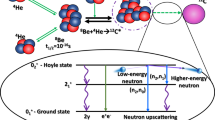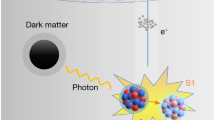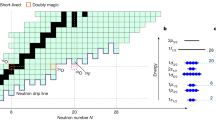Abstract
According to a number of suggestions, stable strange matter could exist in the form of supermassive nuclei (or 'strange nuggets')1,2. In contrast to ordinary nuclei, which contain only 'up' and 'down' quarks, a piece of strange matter should comprise a mixture of 'up', 'down' and 'strange' quarks in roughly equal proportions. Small amounts of strange matter could have survived from the early stages of the Universe1. Alternatively, strange matter might reach the Earth as a flux of strange nuggets produced in collisions of neutron stars3. Limits to the cosmic flux of strange nuggets with masses in the range from 10−4 to 250 g have been obtained in a search for light produced by the nuggets in the upper atmosphere4. Here we report the results of a search for supermassive nuclei by using Rutherford backscattering of heavy ions. The method is sensitive to a broad range of masses extending to those that exceed the projectile mass by several orders of magnitude. Upper limits for the abundance of strange nuggets with masses A ≈ 4 × 102 to 107 AMU relative to the number of nucleons were found to be in the range 10−10 to 10−14.
This is a preview of subscription content, access via your institution
Access options
Subscribe to this journal
Receive 51 print issues and online access
$199.00 per year
only $3.90 per issue
Buy this article
- Purchase on Springer Link
- Instant access to full article PDF
Prices may be subject to local taxes which are calculated during checkout
Similar content being viewed by others
References
Witten, E. Phys. Rev. D30, 272–285 (1984).
Farhi, E. & Jaffe, R. L. Phys. Rev. D 30, 2379–2390 (1984).
De Rújula, A. & Glashow, S. L. Nature 312, 734–737 (1984).
Porter, N. A., Fegan, D. J., MacNeill, G. C. & Weekes, T. C. Nature 316, 49 (1985).
Franz, G., Kratz, J. V., Brüchle, W., Folger, H. & Haefner, B. Z. Phys. A 291, 167–174 (1979).
Breskin, A., Chechik, R., Levin, I. & Zwang, N. Nucl. Instrum. Meth. 217, 107–111 (1983).
Northcliffe, L. C. & Schilling, R. F. Nucl. Data Tables A 7, 233–463 (1970).
Farhi, E. & Jaffe, R. L. Phys. Rev. D 32, 2452–2455 (1985).
Hemmick, T. K. et al. Nucl. Instrum. Meth. B 29, 389–392 (1987).
Wolfram, S. Phys. Lett. 82B, 65–68 (1979).
Ellis, J., Gaisser, T. K. & Steigman, G. Nucl. Phys. B 177, 427–444 (1981).
Cahn, R. N. & Glashow, S. L. Science 213, 607–611 (1981).
Cowan, G. A. & Haxton, W. C. Science 216, 51–54 (1982).
Hoffman, D. C., Lawrence, F.O., Mewherter, J. L. & Rourke, F. M. Nature 234, 132 (1971).
Author information
Authors and Affiliations
Rights and permissions
About this article
Cite this article
Brügger, M., Lützenkirchen, K., Polikanov, S. et al. Search for strange matter by Rutherford backscattering. Nature 337, 434–436 (1989). https://doi.org/10.1038/337434a0
Received:
Accepted:
Issue Date:
DOI: https://doi.org/10.1038/337434a0
This article is cited by
-
Search for supermassive nuclei in nature
Zeitschrift f�r Physik A Hadrons and Nuclei (1991)
-
Auf der Suche nach ?seltsamer? Materie
Naturwissenschaften (1991)
-
Engineering with quark matter
Nature (1989)
-
History lesson
Nature (1989)
Comments
By submitting a comment you agree to abide by our Terms and Community Guidelines. If you find something abusive or that does not comply with our terms or guidelines please flag it as inappropriate.



